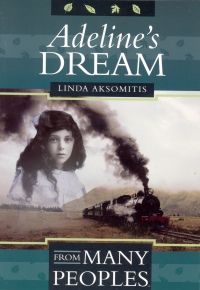| ________________
CM . . .
. Volume XII Number 7 . . . .November 25, 2005
excerpt:
Adeline "Linna" Mueller, the central character of Adeline's Dream, has wanted to sing on stage ever since she heard the opera singer Gisela Staudigl perform songs from Tristan and Isolde at a castle in Germany. Linna has practised the same lieder as the great Staudigl and can do parts from the opera as well. Unfortunately - or fortunately - Linna must leave Germany when her father loses his job. The Berlin Bank where he worked was taken over by the Commerz-und-Disconto Bank, and so he left for Canada in the early years of the 20th century to seek his fortune. As the story opens, it is 1910, and Linna, her brother Konrad, and her mother are finally joining Papa in Qu'appelle, Saskatchewan. Qu'appelle is a growing town with five grain elevators and a flour mill where Mr. Mueller works. The "vast emptiness of the prairie" shocks Linna, but not as much as her new home does. Although the Muellers were upper class in Germany (her aunt was a maidservant), they were expecting something better than a sod shanty in a squatter community on Canadian Pacific Railway land on the edge of town. Eventually they adjust to life in one room with a metal bed, two bunks and the walls covered in newspaper, and they find a bit of used tarpaulin to tack on the ceiling. Linna is a plucky little thing, however, and does not waste time complaining about living conditions or wishing she lived in a big house with a veranda like the one where snobbish young Sarah Booker resides, for she is far too busy doing chores and learning English. Author Linda Aksomitis demonstrates considerable skill in constructing this novel. As a long-time resident of Qu'appelle, she knows the town's history, and she subtly seeds the novel with examples of life there in 1910. Wild strawberries, saskatoons, lamb's quarters and dandelions (when tender) were staples of poor people's summertime diets. Entertainment outside the home included the fair, a slide show with piano accompaniment at church, and the school Christmas concert. When Linna gets a new dress, it must be of "serviceable" fabric that will wear well and not show dirt. Readers of all ages like to learn new things if they are blended skillfully into the story. In plotting a novel, one time-tested approach is to confront the central characters with a series of ever-worsening predicaments. Aksomitis uses this approach successfully in Adeline's Dream. Linna's fate is bound up with that of her family whose survival is threatened when the flour mill burns, putting her father out of work again. He finds temporary jobs as a rough carpenter and farmhand, and he does accounting for Mr. Booker, the richest man in town, but this piecemeal employment cannot support the family long-term. Letters from Germany tell of changes in the old family life there, making it clear to Linna that they cannot return. While Sarah Booker is being mean to Linna at school, the family suffers yet another calamity. When Qu'appelle holds a liquor plebiscite and the sod shanty community votes "wet," the Women's Christian Temperance Union (W.C.T.U.) blames the squatters for swinging the vote and forces the CPR to sell the land where the sod houses are located. Winter is coming, and Linna's family won't have a roof over their heads! Then there is a Dickensian twist of fate. Fortune smiles upon the Muellers. Papa is hired by the Royal Bank upon the recommendation of Mr. Booker. The family can buy land, build a house in town and come up in the world. Meanwhile, Linna's diligence in learning English and her good singing voice win over her classmates, even Sarah Booker.
Cynics raising an eyebrow should reflect that, at this time in our history, old world immigrants with literacy and numeracy skills were much in demand in the west. Would that the skilled and talented could always find their niches! If the other novels in Coteau's "From Many Peoples" series are similar in tone to Adeline's Journey, they will leave young readers with the warm feeling that "God's in his heaven and all is right with the world." Recommended. Ruth Latta's young adult novel, The Secret of White Birch Road (Gatineau, QC, Baico, 2005) was reviewed in the October 13, 2005 issue of CM.
To comment
on this title or this review, send mail to cm@umanitoba.ca.
Copyright © the Manitoba Library Association. Reproduction for personal
use is permitted only if this copyright notice is maintained. Any
other reproduction is prohibited without permission.
NEXT REVIEW |
TABLE OF CONTENTS FOR THIS ISSUE
- November 25, 2005.
AUTHORS |
TITLES |
MEDIA REVIEWS |
PROFILES |
BACK ISSUES |
SEARCH |
CMARCHIVE |
HOME |
